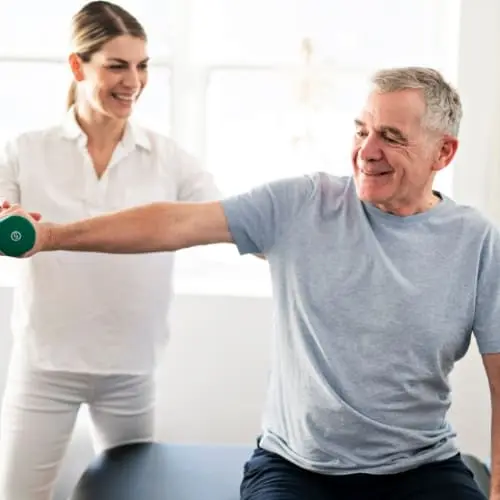Exercises for shoulder pain can help recover strength, reduce pain, and increase mobility. The greatest method to relieve muscle pain and support your shoulder joint so you can resume work or perform your daily tasks involves shoulder joint workouts. This exercise not only strengthens your shoulder joint but also reduces your risk of re-injury.
The right workout for you will depend on the diagnosis and symptoms of the condition causing the muscle pain. The physiotherapist should try to figure out what caused the pain when it first started and what situations made it better or worse to carefully examine the muscle pain in your shoulder. After that, the physiotherapist will recommend exercises for you based on the causes of your muscle pain.
Introduction:
Shoulder pain is a common symptom with multiple possible reasons. You can move your arms because of your shoulder. It is more likely to be damaged due to its extensive range of motion. The most common causes include dislocation, strained muscles, and arthritis. Depending on the underlying cause, therapy may involve medication, rest, or surgery.
An exercise conditioning program will help you get back to your regular activities and lead a healthier, more active lifestyle following surgery or an injury. Following a carefully designed conditioning program could help you return to sports and other hobbies that you enjoy. Among the activities that might help strengthen and improve the shoulder muscles and reduce pain are yoga poses and gentle stretches.
- Strength:
You can do this by strengthening the muscles that support your shoulder joint and preserving stability. Reducing shoulder pain and preventing further injury can be achieved by keeping these muscles strong.
- Flexibility:
Stretching the muscles you have strengthened is necessary to restore range of motion and prevent injury. After performing strengthening activities, gently stretching your muscles may help prevent pain and maintain their length and flexibility.
- Target Muscles: This exercise program targets the following muscle groups:
- Deltoids (front, back, and over the shoulder)
- Trapezius muscles (upper back)
- Rhomboid muscles (upper back)
- Subscapularis (front of shoulder)
- Biceps (front of the upper arm)
- Triceps (back of upper arm)
- Teres muscles (supporting the shoulder joint)
- Supraspinatus (supporting the shoulder joint)
- Infraspinatus (supporting the shoulder joint)
Returning mobility as well as strength is important with any shoulder condition. exercise will help with tissue repair and allow you to get back to your normal activities. Keep your shoulders and any other tense muscles in your body relaxed and released as you perform these exercises. For both short- and long-term benefits, however, a gradual return to regular activity is the best choice to follow after a shoulder condition.
What are Pain Relief Shoulder Exercises?
Anyone might be affected by this frequent joint problem. Tendons, muscles, nerves, ligaments, and cartilage can all cause shoulder pain. The shoulder blade, hand, arm, and neck could also be impacted. It’s important to start treatment early. The recovery from shoulder pain may take up to a few weeks.
Treatments for shoulder pain at home may speed up healing.
What Causes Shoulder Pain?
Many of the reasons for shoulder pain, like fractures, dislocations, and splits, are medical conditions that require immediate treatment before being treated effectively by a physical therapist. Overuse, impingement, and instability are a few common causes of shoulder pain. Here are a few more common causes of shoulder pain.
- Rotator cuff tendonitis
The four muscles that make up the rotator cuff are responsible for both moving and supporting the shoulder. The tendons are attached to the arm bone just behind the shoulder blade’s bony extension. Rotator cuff tendonitis may compress under this bone, causing pain and swelling.
- Biceps tendonitis
Your upper arm’s biceps muscle is connected to the front of your shoulder by the biceps tendon. Ligaments that attach to the collarbone and shoulder blade or the bony structure of the shoulder blade might compress this tendon.
- Bursitis
When the bursa, a fluid-filled sac that allows body parts to move smoothly over one another, is pinched, shoulder bursitis results. The shoulder blade and the humerus bone are separated by a bursa. Pinching of the bursa, a fluid-filled sac that allows body structures to move smoothly over one another, results in shoulder bursitis. Between the shoulder blade and the humerus bone is a bursa.
Frozen shoulder, also known as adhesive capsulitis, is a condition in which the shoulder becomes uncomfortable and gradually loses motion as a result of not using it, a rheumatic disease that is getting worse, a shortage of fluid that assists shoulder movement or bands of tissue that form in the joint and limit motion.
- Arthritis
The degenerative disease known as osteoarthritis damages the cartilage in joints, including the shoulder joint. It may result in shoulder pain, stiffness, and limited range of motion.
Signs and symptoms of shoulder pain:
Although shoulder pain has multiple reasons, the following symptoms may occur whether you move or simply relax;
- Weakness
- Stiffness
- Limited ability to move your arm
- Soreness
- Sharp, stabbing pain
- Swelling
- Bruising
What are the benefits of shoulder joint workouts:
- Exercises help in improving the function of the shoulder joint and reducing shoulder joint pain.
- Improves mobility and range of motion.
- Increases stability by strengthening the muscles surrounding the shoulder joint.
- Regular, safe shoulder stretches can help build long-term flexibility over time.
- There are benefits to physical emotional psychological well-being from exercise. Handling ongoing pain may hurt emotions. Endorphins are hormone-like mood boosters and painkillers that are released after exercise.
- Including exercise in your daily routine will help you better manage your shoulder pain while improving your overall health.
How to decide whether the level of your exercise is right for you:
Pay attention to how much pain you are experiencing when exercising, particularly when doing it first. These exercises might first cause some improvement in your symptoms. They can, however, help to improve shoulder movement with regular exercise and should get easier over time.
You can use this guidance to decide whether the level of your exercise is suitable. It will also allow you to figure out the right level for pain.
Measuring your pain on a scale of 0 to 10, with 10 marking the worst pain you have ever experienced, can be useful. For example, the following;
- 0 to 3 suggests little pain
- 4 to 5 suggests tolerable pain
- 6 to 10 suggests a severe level of pain
Pain experienced when exercising:
Make an effort to keep the scale of your pain between 0 and 5. If your pain reaches this limit, you may change the exercises by:
- lowering a movement’s speed
- Increasing the time of rest between activities
- Decreasing the number of times you do a movement
Pain after exercise:
Your shoulder pain shouldn’t become higher every time you work out. On the other hand, when the body adjusts to new movements, performing new exercises could lead to temporary muscular pain. When you exercise in the morning, the pain you experience should go away soon and not get more severe.
When starting an exercise program, consider these precautions:
Before starting any exercise program, it’s necessary to think about a few safety precautions and minimize the benefits. Consult your physician or physical therapist for advice on which exercises work best for your specific problem.
It’s important to pay attention to your body and avoid from pushing against pain. Exercise often causes some pain, but prolonged or severe pain could indicate that you’re pushing yourself too hard. Start with low-impact workouts and gradually work your way up to more difficult ones as soon as you can handle more pain.
It’s important to keep up with correct technique and form to prevent injuries from happening again. If you’re not sure about how to perform an exercise routine correctly, get help from a doctor. Warm up before any exercise to better prepare your joints and muscles for the workout.
Stretches and Exercises for Shoulder Pain Relief:
Should you experience shoulder pain that is related to trauma or if it has lasted longer than two to three weeks, you might wish to contact a doctor. Certain shoulder pain causes, such as frozen shoulder and rotator cuff problems, worsen over time and may need surgery if non-surgical treatments prove ineffective.
You should think about getting help from a physical therapist if you don’t think your pain requires a trip to the doctor. To do this, you don’t require someone to refer you. After a consultation and analysis of your pain, your physical therapist may use a goniometer to measure your strength and range of motion while monitoring the level of your shoulder mobility. After that, your physical therapist will probably suggest stretches and exercises to help reduce pain and manage inflammation.
Below is a list of the most significant exercises you can do if you have shoulder pain.
Across-the-chest stretch
After completing this exercise, your shoulder joint and the muscles that surround it will become more flexible and have a larger range of motion. If you have shoulder pain during this exercise, lower your arm.
- Take a place on the ground in a comfortable position first.
- Raise your right arm to your chest.
- Using your left hand, hold your arm or place it in the space made by your left elbow.
- Hold this position for a few seconds.
- Then return to your neutral position.
- Then relax.
- Repeat this exercise 3-5 times a day.
- Repeat on the opposite side.
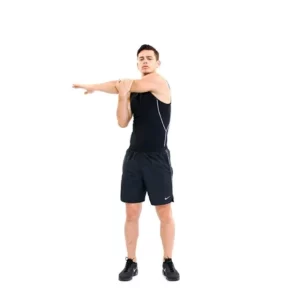
Chest expansion
Your shoulders’ range of motion and flexibility will be improved by this workout.
- Begin in a comfortable standing position on the ground.
- Using both hands, grasp an exercise band, strap, or towel behind your back.
- As you move your shoulder blades toward one another, spread out over your chest.
- Move your chin and raise your eyes to the ceiling.
- Hold this position for a few seconds.
- Then return to your neutral position.
- Then relax.
- Repeat this exercise 3-5 times a day.
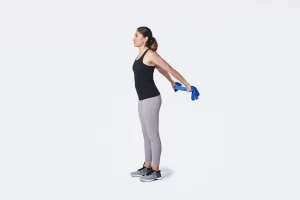
Eagle arms spinal rolls
Your shoulder muscles will be stretched by this workout. Use opposing shoulders for this exercise if the arm position is challenging.
- Stretch your arms out to the sides while seated.
- With your right arm raised, bend your elbows in front of your body.
- With the backs of your hands and forearms together, bend your elbows.
- Move your palms together with the help of your right hand.
- For five to ten seconds hold this pause.
- As you breathe out, pull your elbows in toward your chest and stretch your spine.
- As you breathe in, extend your arms to expand your chest.
- Hold this position for a few seconds.
- Then return to your neutral position.
- Then relax.
- Repeat this exercise 3-5 times a day.
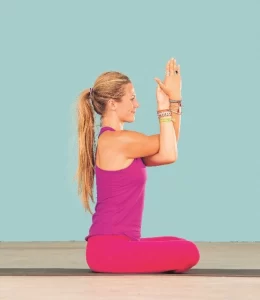
Seated twist
As you perform this exercise, keep your hips pointing forward and allow the rotation to start in your lower back. Your neck and shoulders are going to stretch at this point.
- Begin by taking a comfortable seat in the chair.
- Move the back of your left hand to your thigh while rotating your upper body to the right.
- Put your right hand in a comfortable spot.
- Hold this position for a few seconds.
- Then return to your neutral position.
- Then relax.
- Repeat this exercise 3-5 times a day.
- Repeat on the left side.
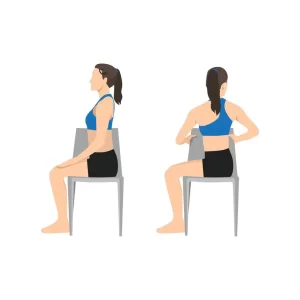
Downward Dog Pose
A multipurpose exercise, downward dog helps to increase your body’s strength, flexibility, and range of motion in both large and small muscles. It’s particularly helpful for Relieving pain in the shoulders, back, and neck.
- Take an all-fours position, placing your shoulders over your wrists and your hips over your knees.
- Raise your hips toward the ceiling by applying pressure with your hands.
- When you equally distribute your weight into your hands and feet, keep your knees slightly bent.
- Move your head toward your feet to bend your shoulders overhead while maintaining a straight spine.
- Hold this position for a few seconds.
- Then return to your neutral position.
- Then relax.
- Repeat this exercise 3-5 times a day.
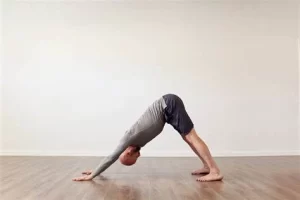
Arm circles
Arm circles are a useful exercise for increasing flexibility and warming up the shoulder joints. Arm circles can be a useful tool for releasing shoulder pain and pressure.
- With your feet hip-width apart, take an upright position.
- Form a T shape with your body by raising and extending your arms to the sides.
- With your arms, move them in little circles.
- Then return to your neutral position.
- Then relax.
- Repeat this exercise 3-5 times a day.
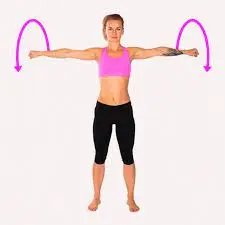
Doorway stretch
A static exercise that can help increase shoulder flexibility, particularly in the pectoralis muscles, is the doorway stretch.
- Take a standing position and face a corner of the room that is near enough to each wall.
- With the fingers pointing upward, flex the elbows and shoulders to a 90-degree angle.
- Put one hand, elbows at shoulder height, against each wall.
- The chest should be stretched by doing this.
- Hold this position for a few seconds.
- Then return to your neutral position.
- Then relax.
- Repeat this exercise 3-5 times a day.
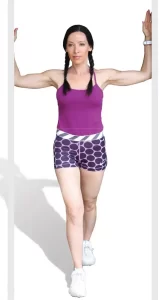
Child’s Pose
Balasana, also known as the Child’s Pose, is a mild, calming yoga pose that stretches the back and shoulders.
- Position your knees slightly wider than hip-width apart on the floor or a yoga mat.
- Place your palms on the mat slightly in front of your shoulders to form a four-pointed pose.
- Rest your abdomen on your thighs by resting on your heels and bending forward at the hips.
- Place your hands in front of you and place your forehead on the ground.
- Press your shoulders and chest into the floor to deepen the stretch.
- Hold this position for a few seconds.
- Then return to your neutral position.
- Then relax.
- Repeat this exercise 3-5 times a day.
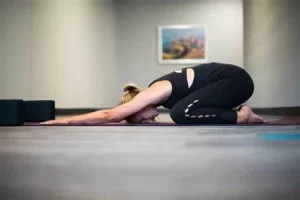
Lateral raises
A shoulder strengthening exercise is the lateral rise. For this exercise, people may use resistance bands, water bottles, or lightweight dumbbells.
- Begin in a comfortable standing position on the ground.
- Step your feet slightly wider than hip-width apart while holding a pair of light dumbbells (less than five pounds).
- Lift the weights to the sides until they are shoulder-level.
- Don’t forget to engage your core.
- Lower the weights to the sides gradually.
- Then return to your neutral position.
- Then relax.
- Repeat this exercise 3-5 times a day.
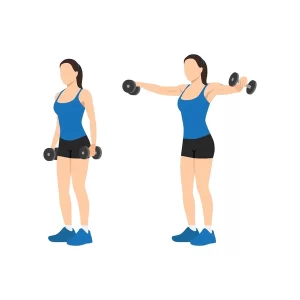
Internal shoulder rotation
Internal rotation may be beneficial for strengthening the shoulder muscles.
- Start by taking a comfortable standing position on the ground.
- A big elastic band or resistance band can be attached to a doorknob.
- Using one hand, grasp the opposite end of the band.
- Move the forearm close to the body while bending the arm at the elbow.
- Hold this position for a few seconds.
- Then return to your neutral position.
- Then relax.
- Repeat this exercise 3-5 times a day.
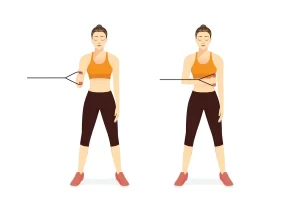
Reverse fly
The posterior deltoids, or back of the shoulder muscles, are worked during the reverse fly exercise. Dumbbells or resistance bands will be required.
- Standing straight on the ground, take a few deep breaths.
- Bend forward at the hips and extend your arms straight out.
- Raise both arms out to the sides, palms facing inward, and squeeze your shoulder blades together.
- Hold this position for a few seconds.
- Lower your arms gently.
- Then return to your neutral position.
- Then relax.
- Repeat this exercise 3-5 times a day.
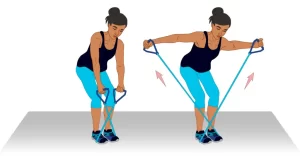
Pendulum
A passive shoulder exercise that is frequently recommended for shoulder rehabilitation is the pendulum exercise. It doesn’t require contracting muscles and supports the joint’s passive range of motion.
- Standing straight on the ground, take a few deep breaths.
- For support, bend forward and rest one hand on a counter or table.
- The opposite arm should be left hanging at your side.
- Swing your arm back and forth gently.
- Step your arm side to side while you perform the exercise again, then move it circularly.
- Then return to your neutral position.
- Then relax.
- Repeat this exercise 3-5 times a day.
- Repeat every step with the other arm.
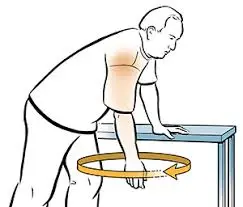
Passive Internal Rotation
This stretch should be felt in the front of your shoulder.
- Standing straight on the ground, take a few deep breaths.
- With one hand, hold a stick behind your back, and with the other, lightly grab its opposite end.
- To passively stretch your shoulder to the point where you feel a pull without experiencing pain move stick.
- Then return to your neutral position.
- Then relax.
- Repeat this exercise 3-5 times a day.
- With the other arm, repeat the whole procedure.
- When pulling the stick, avoid bending over or twisting to one side.
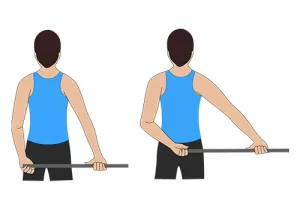
Passive External Rotation
Your shoulder’s back should feel stretched during this stretch.
- Standing straight on the ground, take a few deep breaths.
- With one hand, hold the stick, and the other, hold the opposite end of the stick.
- As you push the stick vertically keep the elbow of the shoulder you are stretching against your side of the body until you feel a pull that is not painful.
- Then return to your neutral position.
- Then relax.
- Repeat this exercise 3-5 times a day.
- With the other arm, repeat the whole procedure.
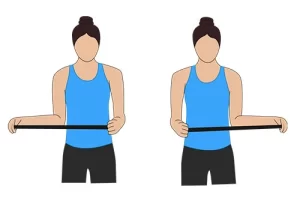
Standing Row
This workout is to feel like it goes into your upper back and behind your shoulder.
- Begin in a comfortable standing position on the surface of the ground.
- The back of your shoulder should feel stretched.
- Using the elastic band, create a loop that is three feet long, then connect the ends.
- Attach the loop to a stable item, such as a doorknob.
- With your elbow bent and by your side, hold the band as you stand.
- Keeping your arm close to your side, carefully move your elbow back straight.
- Pull while contracting your shoulder blades together.
- Then return to your neutral position.
- Then relax.
- Repeat this exercise 3-5 times a day.
- With the other arm, repeat the whole procedure.
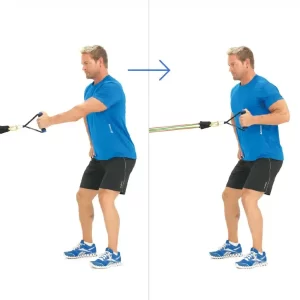
Bent-Over Horizontal Abduction
This workout has to feel like it goes into your upper back and behind your shoulder.
- Your affected arm should be hanging over the side of the table or bed as you lie on your stomach.
- Lift your arm to eye level gently while maintaining a straight arm.
- Hold this position for a few seconds.
- Lower your arms gently.
- Then return to your neutral position.
- Then relax.
- Repeat this exercise 3-5 times a day.
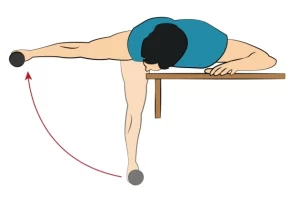
Wand flexion
Regular practice of this exercise helps strengthen your upper back and shoulder muscles.
- Start in a comfortable standing position on the ground.
- Your hands should be shoulder-width apart when you hold a stick.
- Carefully extend your arms in front of you.
- Let your unaffected arm raise your affected arm while you relax the affected arm.
- When performing the movements, move gently.
- Hold this position for a few seconds.
- Lower your arms gently.
- Then return to your neutral position.
- Then relax.
- Repeat this exercise 3-5 times a day.
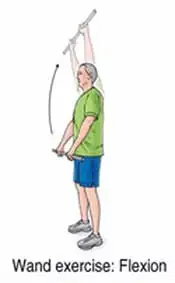
Internal and external rotation
- Lay down on your back on a level surface.
- Bend your elbow 90 degrees to point your fingers upward while you extend your arm straight out from your shoulder.
- Move your arm slowly at the ideal angle while maintaining your elbow bent and your body in the proper position.
- Lower your elbow to a 45° angle if you have pain at a 90° angle.
- Then return to your neutral position.
- Then relax.
- Repeat this exercise 3-5 times a day.
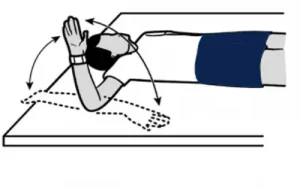
Shoulder rolls
Shoulder rolls can reduce shoulder pain by increasing circulation and releasing tension in the shoulder muscles.
- Starting by taking a comfortable standing position on the ground.
- Give your arms free to rest at your sides.
- Inhale deeply and lift your shoulders to your ears.
- Scapulae should be squeezed together as you bring your shoulders back.
- Take a breath out and relax your shoulders.
- Feel the stretch at the back of your shoulders as you extend your elbows forward.
- Then return to your neutral position.
- Then relax.
- Repeat this exercise 3-5 times a day.
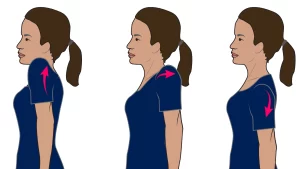
Wand extension
Regular practice of this exercise helps strengthen your upper back and shoulder muscles.
- Consider placing yourself on the ground in a comfortable standing position first.
- With both hands, hold a stick behind your back.
- Extend the stick behind you.
- Hold this position for a few seconds.
- Then return to your neutral position.
- Then relax.
- Repeat this exercise 3-5 times a day.
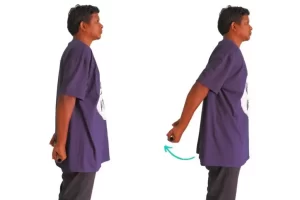
Shoulder abduction and adduction
Your shoulder and upper back muscles will get stronger with regular use of the horizontal shoulder abduction exercise.
- Starting in a comfortable standing position on the ground.
- Hold a stick with both hands.
- Squeeze the stick between your front thighs.
- Push the other arm as far up and to the side with one arm as you can while maintaining a straight elbow.
- Then return to your neutral position.
- Then relax.
- Repeat this exercise 3-5 times a day.
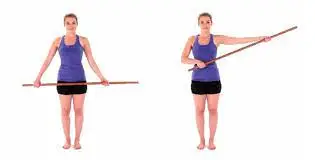
Elbow Flexion
Your capacity to turn your arm over and bend and straighten your elbows will increase with elbow range of motion exercises.
- Starting in a comfortable standing position on the ground.
- You should raise the weight to your shoulder gradually while maintaining your elbow near your side.
- Hold this position for a few seconds.
- Then return to your neutral position.
- Then relax.
- Repeat this exercise 3-5 times a day.
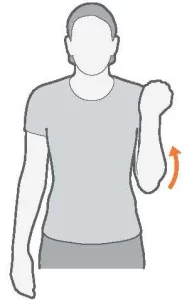
Extension of the Elbow
Exercise promotes blood flow, flexibility, and strength in the surrounding muscles of the joint, all of which help the healing process.
- Start in a relaxing standing position on the ground.
- Lift and flex your elbow while supporting your head.
- Raise your upper arm with the other hand to give support.
- Then slowly extend your elbow to a comfortable level.
- Hold this position for a few seconds.
- Then return to your neutral position.
- Then relax.
- Repeat this exercise 3-5 times a day.
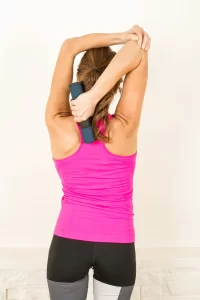
Shoulder pulley
The rotator cuff and shoulder joint can be gently stretched and given more range of motion with the help of the shoulder rope and pulley workout.
- As you sit on the chair exactly below the shoulder pulley, attach it to the door.
- With your palms facing each other, grasp both ends of the pulley.
- You may direct the right arm up by using your “good” hand to pull the handle down to and over the knee.
- Raise and hold your stiff arm as high over your head as you can.
- Then return to your neutral position.
- Then relax.
- Repeat this exercise 3-5 times a day.
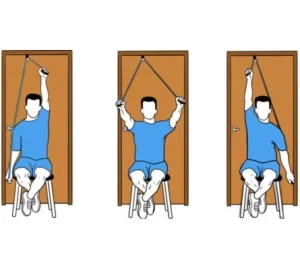
Wall Press Ups
Wall pushups focus on the muscles of the upper body, including the arms, shoulders, and chest.
- Raise your arms forward so that your hands just touch the wall while facing the wall with your elbows straight.
- Maintain the extension position of all your fingers and both hands at shoulder height on the wall.
- Move carefully in the direction of the wall if you feel that you are reaching too far.
- Bend your body slowly toward the wall until your nose makes contact with it while extending your elbow slowly.
- Bend your elbows at a 45-degree angle rather than straight out to the sides, and maintain a straight back.
- Then return to your neutral position.
- Then relax.
- Repeat this exercise 3-5 times a day.
- It is not suitable to lean your back against the wall when pressing against it.
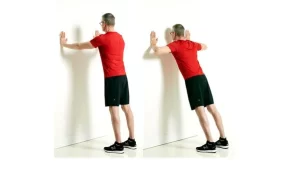
Towel shoulder strech
To increase shoulder range of motion and flexibility, try the towel shoulder stretch.
- Starting in a comfortable standing position on the ground.
- Take a long towel, such as that for a swim or bath.
- With one hand, hold the towel and put it across your back and shoulder.
- Placing the towel on your left shoulder and holding it with your left hand, extend your right shoulder.
- Reach back and pick up the towel with your other hand.
- With care, lift the towel and raise your hands behind your back.
- A light stretch on the front or side of the shoulder is good.
- Hold this position for a few seconds.
- Then return to your neutral position.
- Then relax.
- Repeat this exercise 3-5 times a day.

Finger ladder Exercises
Your finger, wrist, arm, and shoulder range of motion will all be stretched and increased with this workout.
- The patient faces a ladder that rests over a wall while standing.
- Recommend that they carefully place their affected hands on the low step of the ladder.
- Next, gently start climbing the finger ladder up to the top and then gradually return to the beginning.
- Then return to your neutral position.
- Then relax.
- Repeat this exercise 3-5 times a day.

Sleeper stretch
The posterior shoulder mobility and internal shoulder rotation were significantly improved by sleeper stretches.
- Flex your elbow to a 90-degree angle while lying on your side on a level surface with your affected arm on the table.
- Next, use the opposing arm to gradually provide pressure to your forearm.
- Hold this position for a few seconds.
- Then return to your neutral position.
- Then relax.
- Repeat this exercise 3-5 times a day.
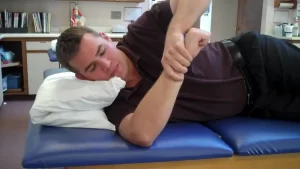
Straight arm dumbbell row
Dumbbell rows also help in the development of upper arm muscles. It can therefore be used to strengthen the triceps and biceps.
- Bend forward so that your hand supports your weight and place your knee, a chair, or a bench.
- Use a dumbbell.
- Raise your weight slowly so that it is parallel to the floor and turn your hand so that it is facing up.
- Maintain a straight arm.
- Hold this position for a few seconds.
- Then return to your neutral position.
- Then relax.
- Repeat this exercise 3-5 times a day.
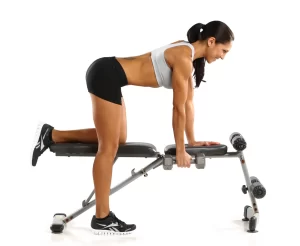
Ragdoll Pose
A forward-bend yoga pose called Ragdoll may help reduce shoulder tightness.
- While standing, place your feet hip-width apart.
- Bend your knees just a little bit.
- Bend forward and trying to connect your toes.
- For lower back support, press your tummy against your bent knees.
- Put a hand on each arm’s elbow on the other.
- Heads should be positioned with their tops facing the floor.
- Head down gently to release tension in the shoulders and neck.
- Then return to your neutral position.
- Then relax.
- Repeat this exercise 3-5 times a day.
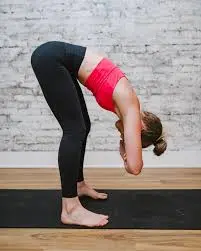
Side-lying thoracic rotation
This shoulder stretch helps in improving lumbar, thoracic, and shoulder mobility.
- Lie on your right side either on a mat or the ground.
- Slightly bend your knees.
- Extend your right arm straight forward.
- Placing the left hand over the right is okay.
- Maintain a concentrated look on the left hand.
- Raise your left hand straight.
- Move your left arm in the direction of the floor behind your back, making a motion similar to making a line.
- At all times maintain the right hip and knee posture.
- Return the left arm to the right hand’s side.
- Then return to your neutral position.
- Then relax.
- Repeat this exercise 3-5 times a day.
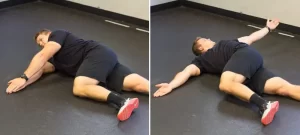
Side-Lying External Rotation
The purpose of this exercise is to strengthen the muscles of the posterior rotator cuff.
- On the floor or a bed, lie on your side.
- With your forearm lying palm down against your chest and your elbow bent 90 degrees, place your upper arm by your side.
- Raise your forearm till it is level with your shoulder by rotating your shoulder out.
- Hold this position for a few seconds.
- Slowly lower your hand.
- Then return to your neutral position.
- Then relax.
- Repeat this exercise 3-5 times a day.
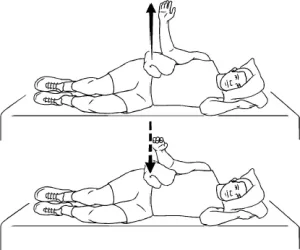
Neck Stretches
Easy neck stretches are great because shoulder pain is frequently related to the neck. You can do this exercise as a warm-up as well.
- Start in a comfortable standing position on the ground.
- The arm should be freely bent on the right side.
- Look straight ahead.
- Try to touch your ear to your shoulder with your head tilted to the right.
- The stretch along your left shoulder and neck will be felt.
- Hold this position for a few seconds.
- Then return to your neutral position.
- Then relax.
- Repeat this exercise 3-5 times a day.
- Repeat the exercise on the other side.

The Reverse Shoulder Stretch
It is a really simple exercise that doesn’t require any special equipment. This will help in stretching the muscle on the backs of your shoulders, the posterior deltoid.
- Maintain a straight posture.
- Cross your fingers behind your back at the top of your butt to create the shape of a U.
- Maintain a straight back with your shoulder blades together.
- Maintain a straight arm bone on each arm.
- Extend your arms and keep them low, away from your lower back.
- Hold this position for a few seconds.
- Then return to your neutral position.
- Then relax.
- Repeat this exercise 3-5 times a day.
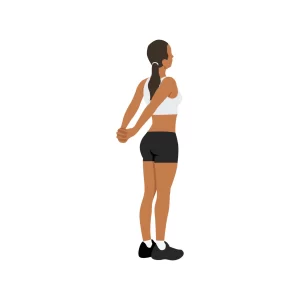
Rhomboid Rows
You can keep your posture with the help of your rhomboid muscles. You can treat your shoulder joints and get rid of shoulder aches by performing a rhomboid row.
- For this exercise, you will need an incline bench and a pair of dumbbells.
- Each hand should take a pair of dumbbells.
- As you stand, turn to face the incline bench’s seat.
- Stretch your upper body forward and hug the seat as you move forward.
- Bend your knees to let your feet slide backward.
- To provide support, flex both ankles and press your toes into the ground.
- You need to be hanging your arms down.
- Breathe out and bend your elbows to raise the weights in the direction of your rib cage.
- Squeeze your shoulder blades together when you’ve reached the top of the raise movement.
- Hold this position for a few seconds.
- Then return to your neutral position.
- Then relax.
- Repeat this exercise 3-5 times a day.
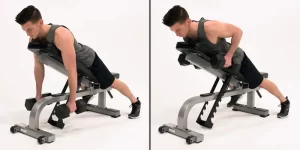
Guidelines to follow when exercising:
It is best to begin shoulder pain exercises only after consulting a physician or physical therapist. It’s important to regularly perform safe, proper exercises that consider your specific situation.
- If you get any kind of pain during exercising, stop right away.
- Before practicing exercise, warm up and stretch.
- Dress comfortably so that your body may move easily while working out, and avoid wearing anything too tight.
- It is important to perform all exercises under the protocol, which includes the right number of repetitions for each exercise as well as stretches before and pauses in between.
- Between workouts, give yourself a rest.
- Eat lightly before exercising.
- Avoid exercising on an empty stomach and avoid eating straight after exercise.
- While stretching a tight muscle hurts, it’s safe to do so. However, as you stretch, you shouldn’t experience any intense or stabbing pain.
- Stay away from intense exercise.
- To prevent injury, make sure you have enough space around you and remember to drink water when exercising.
When did you not exercise?
- If resting has been recommended by your physician.
- If you recently suffered an injury to one of your upper limbs.
- If performing this exercise causes you any pain.
- Fever
- Headache
Tips to prevent shoulder pain:
Simple shoulder exercises can improve the strength and flexibility of the rotator cuff muscles and tendons. physical therapist can teach you how to do these correctly. Use ice for fifteen minutes following exercise if you have had shoulder problems in the past to avoid further injury.
You can avoid shoulder pain by following a few basic guidelines and suggestions;
- Maintain proper posture when standing, sitting, and going about your everyday routine to prevent bending over or hunching over.
- Keep your shoulders and other muscles in shape by exercising.
- During the day, pay attention to how you’re moving your body and make any required adjustments.
- Rest well and avoid participating in any painful activities for some time.
- A healthy amount of calcium and vitamin D is necessary for the health of your bones.
Take care when doing duties that require you to bend forward, hold heavy objects, or reach up. If your job requires you to perform these tasks, consider how you can shift your body to reduce pain. Make sure you’re using good technique and form if you play sports that cause shoulder pain.
Good suggestions:
- Take it as a guide, and over time, progressively increase the entire movement.
- Maintaining shoulder mobility is important because muscles require movement to stay healthy.
- You do not need to complete every exercise at once.
- Don’t feel pressured to perform the entire workout movement immediately.
- If a specific movement hurts, track your improvement each week by noting how this movement becomes better.
- It may take up to a few weeks to experience a noticeable improvement in your pain, strength, and range of motion, a full recovery may take longer.
- Try to keep up with additional enjoyable hobbies to stay in shape, as movement, in general, can be helpful in your recovery. A short walk could be quite beneficial.
Exercises Not to Do if You’re Experiencing Shoulder Pain:
The shoulder workouts you should not perform are listed below.
- Behind the Head Shoulder Press
Your rotator cuff muscles must be compressed against the shoulder’s bony surfaces to do this workout. This could hurt a little. If you start to feel uncomfortable, stop the workout.
- Bench Dip Triceps
Pressure must be applied to the rotator cuff, triceps, and tendons during this exercise. If you are in pain or uncomfortable during this workout, stay away from it and think of other activities.
- Single Arm Row
This is an activity that most people do wrong, which leads to injury.
When to visit a doctor for advice:
If you are unable to move your shoulders or if, even after a couple of weeks of treatment, the pain doesn’t get better, see a physician or physical therapist.
If you develop a fever or have severe pain in either or both of your shoulders, if the shoulder feels warm to the touch, looks swollen, or reddish, or if you experience hand or arm numbness, you should also consult a physician immediately.
An MRI, ultrasound, or X-ray may be performed by a doctor to identify the source of the awkwardness and the best course of action.
Summary
Shoulder pain is common, but it may be prevented and treated. To avoid and treat shoulder pain, do regular workouts. Being unable to do daily tasks might be severely affected by shoulder pain. Even after you start to feel better, keeping up with the exercises and treatments will help keep the pain from returning. To relieve pain and promote recovery, you might try home remedies along with shoulder workouts.
Resuming your regular exercise routine may require some time, and the first effects may not be seen right away. To prevent such shoulder pain from getting worse, you need to give your body enough rest and attention.
Consult a doctor before beginning any workout program if you have any potentially affecting medical conditions.
FAQ:
What kind of exercise is best for shoulder pain?
Seated twist
Arm circles
Lateral raises
Internal shoulder rotation
Pendulum
Passive Internal Rotation
Passive External Rotation
What’s the best way to treat shoulder pain?
Apply ice to the shoulder area for fifteen minutes, then remove.
Give your shoulder some rest for the upcoming days.
Return gradually to your everyday routine.
Acetaminophen (like Tylenol) or ibuprofen can help reduce pain and inflammation.
Why am I experiencing shoulder pain?
There are many different kinds of shoulder pain. Maybe you overdid a task like painting, or you hurt it in a fall or other accident. In certain cases, arthritis is the cause of shoulder pain. Pain that is “referred” indicates that there’s a chance it comes from problems in other parts of your body.
Can physical activity relieve shoulder pain?
Pain relief and shoulder stretching and strengthening can be achieved with exercises like yoga poses and mild stretches. After closing your eyes and inhaling deeply, focus your attention on your shoulders and note how they feel.
Is it possible for walking to relieve shoulder pain?
A major cause of neck and shoulder pain is prolonged periods of sitting in front of a computer. Walking, swimming, cycling, or doing anything that keeps you moving can all help the pain just by moving you out of that posture.
When I have shoulder pain, which workouts should I avoid?
Lifts Overhead
Lat pulldown exercises
Bench Dips
How can someone with shoulder pain sleep?
When you’re having shoulder pain, think about lying on your back or the side that isn’t affected. To relieve some of the pressure, position some pillows under the affected arm. An hour or so before going to bed, you can also take some painkillers that can help with some of the related pain.
Shoulder pain: is it curable?
The two primary treatments for shoulder injury are rest and physical therapy. Your doctor may suggest a local anesthetic and steroid injection to relieve the pain. If therapy doesn’t relieve the pain or it comes back after a few months, surgery can be recommended.
Shoulder pain: Can I endure it?
If non-surgical treatments are successful, then you can live with a torn rotator cuff without having surgery. These may consist of bed rest, immobilization, medications that reduce inflammation, injections of steroids (cortisone), and physical therapy.
How long may shoulder pain last?
It may take four to six weeks for minor shoulder pain to go away completely. There are some activities you should and shouldn’t do to help heal shoulder pain. When using these exercises for shoulder pain, results usually begin to improve after two weeks.
When I have shoulder pain, can I still exercise?
After an accident, simple physical therapy for shoulder pain may help you rebuild your strength and maintain a regular exercise routine. Once your doctor gives you advice, begin the healing process with basic shoulder exercises.
What is the process for diagnosing shoulder pain?
To help identify the source of your pain and any other issues, your doctor could ask for certain tests. radiography. Any injury to the bones that comprise your shoulder joint will be visible on an X-ray. magnetic resonance imaging (MRI) and ultrasound.
How can I strengthen my shoulder joints?
Strong rotator cuff muscles improve shoulder joint stability and reduce the risk of injury. These muscles grow more flexible when you stretch them regularly. Increased range of motion from flexibility can help keep off injuries.
Will a shoulder recover in a week?
Depending on how severe it is.
In most minor situations, a week or two is all it takes to comfortably return to normal activities after suffering a strain or sprain of the shoulder. However, not every sprain is minor. Six to eight weeks may be needed for more mild sprains.
Does shoulder pain require activity or rest?
To reduce pain and release tense muscles, apply a heat compress. Take it easy on the injured shoulder and stay away from demanding tasks like lifting big objects. To increase range of motion and flexibility, perform mobility exercises for the upper back and shoulders regularly.
How is instability in the shoulder fixed?
Exercises for shoulder instability and physical treatment to build muscle over several weeks.
Change your activities to reduce shoulder strain and stay away from moves that stress your shoulder.
Anti-inflammatory medications to relieve pain and swelling.
How can you tell if shoulder pain originates from a joint or muscle?
When a muscle group is affected by shoulder pain, it is typically situated above or below the joint, normal joint movement is pain-free, and joint pain is absent. Although the range of motion in shoulder joints is complete, stability is lost.
What meal is most beneficial for treating shoulder pain?
Vitamins that reduce inflammation are prevalent in colorful fruits and vegetables, including cruciferous vegetables, green leaves, and fruits. Nuts, avocados, and olive oil are examples of healthy fats that include anti-inflammatory components.
What is the duration of shoulder rest?
Four to six weeks may pass before mild shoulder pain completely goes away. Certain actions that you should and shouldn’t do may relieve shoulder pain. These exercises usually take two weeks to start showing results for shoulder pain.
Which stretches work best for treating shoulder pain?
Across-the-chest stretch
Doorway stretch
Towel shoulder stretch
Sleeper stretch
Neck Stretches
The Reverse Shoulder Stretch
After suffering a shoulder injury, when should you begin exercising?
Although the process could hurt at first, it’s a necessary step in healing. Start modest activity after a few weeks. You should be able to actively move the shoulder on your own by this point in your recovery.
Do injuries to the shoulder ever totally heal?
You can typically get good function without surgery, even though the majority of tears cannot heal on their own. Surgery is typically advised, though, if you are physically active or use your arm for sports or overhead tasks, as many tears cannot heal on their own.
What not to do following a shoulder injury?
Avoid long-term use of your arms above shoulder level when working. Use a ladder or footstool if necessary. Lift and hold items close to your body. Avoid lifting large objects over your head or away from your body.
Why is the healing process for shoulder injuries so slow?
When you choose a careful approach, there are a few reasons why your recovery might not be as quick as you would like. One of the offenders is age. There is insufficient blood flow to the rotator cuff tendons where they connect to the humerus. Because of wear and strain, we are therefore more likely to get a rotator cuff injury as we become older.
How can shoulder pain be prevented?
You can treat your shoulder pain in a few different ways;
Pain relievers.
Cold or heat therapy.
Posture correction.
Reduce the level of intensity.
Get some rest and exercise.
Supplemental treatment.
What’s better for a shoulder, heat, or ice?
Heat may aggravate an injury, while ice works faster to reduce edema, inflammation, and pain early on. Applying heat is allowed if your injury is chronic (older than six weeks). Joint pain is relieved and tense muscles are relaxed by the increased blood flow.
References
- Exercises to address joint and muscular issues in the shoulders | NHS inform. (2024, February 6). Exercises for Shoulder Problems: https://www.nhsinform.scot/illnesses-and-conditions/muscle-bone-and-joints/ Reference inside text: (Exercises for Joint and Muscle Issues in the Shoulder | NHS Inform, 2024)
- E. Cronkleton (2023, Feb. 3). The Top 10 Exercises for Treating Tightness and Shoulder Pain. Neck release exercises for shoulder pain: https://www.healthline.com/health/shoulder-pain-exercises
Citation within the text: (Cronkleton, 2023) - Eske, J. March 3, 2023. Ten exercises to help with shoulder ache. exercises for shoulder pain: https://www.medicalnewstoday.com/articles/
Reference inside text: (Eske, 2023) - Four Powerful Stretches and Exercises to Alleviate Shoulder Pain. June 6, 2022. Ability Rehabilitation. Four efficient stretches and exercises to treat shoulder discomfort. https://abilityrehabilitation.com/athletic-training/
Text reference: “Four Beneficial Exercises and Stretches to Reduce Shoulder Pain, 2022” - L. Burgess (2024, Jan. 22). The top ten shoulder stretches for tension. The outlook is given in the article “324647” on Medical News Today.
Reference within the text: Burgess (2024) - 13 Printable PDF Physical Therapy Exercises for Rehab & Shoulder Pain. August 18, 2023. Doctor Sporty. In-Text Citation: (13 Physical Therapy Exercises for Shoulder Pain & Rehab (Printable PDF), 2023) https://sportydoctor.com/exercises-for-shoulder-pain/
- Inverarity, L. Oct. 16, 2023. Exercises to Strengthen Your Shoulders. Verywell Medical. This page provides rotator cuff strengthening exercises (2696604).
Citation within the text: (Inverarity, 2023) - Image 1, Stretch – Cross Body Arms While Standing. skimble.com (n.d.). How to do the standing cross-body arms exercise? https://www.skimble.com/exercises/30657-stretch
Stretch – Standing Cross Body Arms, n.d. is the in-text citation. - Image 2, L. I. Pt. (2022, Sept. 22). How to Perform a Towel Chest Stretch. well-fitting. The Pectoral Stretch Exercise (2696346) can be found at https://www.verywellfit.com.
Citation inside text: (Pt, 2022) - Image 3, H. N. E. (November 29, 1851). wings outstretched in a spread eagle. s1-IV(109), 424–424, Notes and Queries, https://doi.org/10.1093/nq/s1-iv.109.424g
Citation inside the text: (H. N. E., 1851) - Image 4, Putra, L. (January 3, 2023). Download the image of a woman performing an ardha matsyendrasana (chair spinal twist). Isolated flat vector illustration… Vecteezy. https://www.vecteezy.com/vector-art/6417630-woman-exercising-flat-vector-illustration-on-white-background-spinal-twist-ardha-matsyendrasana
Citation within text: (Putra, 2023) - Image 6, 16149827 – Online Store. (n.d.). https://superrask.xyz/product_details/16149827.html In-Text Citation: (16149827 – Online Store, n.d.)
- Image 10, Support for GDPR. (n.d.). The range of motion in the shoulder is improved by internal rotation, as demonstrated by the exercise of the month (PI6FY4U6PVGKTB4XTWRDS5JYZE).
Reference within the text: (GDPR Support, n.d.) - Image 11, 7 Best Back Exercises with Resistance Band [Videos Included]. August 19, 2022. Doctor Sporty. Back exercises using the resistance band: https://sportydoctor.com/
“The Best 7 Resistance Band Back Exercises with Videos,” 2022, is cited inside. - Image 13, Thompson, T. (November 21, 2023). 18 Shoulder Rehabilitation Exercises (Free PDF Download). The patient works out. www.patientexercises.com/18-free-pdf-download-exercises-for-shoulder-rehabilitation/
Reference within the text: Thompson, 2023 - Image 14, November 21, 2023: Thompson, T. 18 Shoulder Rehabilitation Exercises (Free Download in PDF Format). The patient exercises. This is a free PDF download for 18 exercises for shoulder rehabilitation from patientexercises.com.
In-text Reference: Thompson, 2023 - Image 15, Exercise for the Upper Back: Standing Single Arm Back Row with Bands (2022, October 6). Bodylastics. https://bodylastics.com/workout/band-supported-standing-one-arm-back row/
In-text Citation: (Top Back Exercise: Standing One Arm Back Row With Bands, 2022). - Image 16, On August 30, 2022, AlAnazi, A., Alghadir, A. H., and Gabr, S. A. Patients with Primary Subacromial Impingement Syndrome see changes in their rotator cuff muscle strength, function, and pain when they perform handgrip strength exercises. International BioMed Research, 2022, 1–17. 9151831; https://doi.org/10.1155/2022
Reference within the text: AlAnazi et al., 2022 - Image 17, Lehmann, G. (November 16, 2022). Five Simple Broomstick Exercises to Improve Shoulder Mobility Flex Health Professionals is a Mandurah chiropractor and massage therapist. Five simple exercises to improve shoulder mobility: https://flexhealthprofessionals.com.au
Reference within the text: Lehmann, 2022 - Image 18, MYORTHO CLINIC | SHOULDER PHYSIOTHERAPY (n.d.). The shoulder at https://myorthoclinic.in Reference inside text: (MYORTHO CLINIC | SHOULDER PHYSIOTHERAPY, n.d.)
- Image 20, Ekka, S. S. (February 11, 2023). Four Simple Shoulder Wand Exercises to Help with Sore, Stiff Shoulders. https://physiosunit.com/shoulder-wand-exercise-2/ Physiosunit
Reference inside text: (Ekka, 2023) - Image 21, On September 11th, 2019, Cfp, T. F. D. M. What to Expect Following Rotator Cuff Repair After Surgery? PTProgress | Resources for Physical Therapy Education Available to All. Exercises for Rotator Cuff Surgery: https://www.ptprogress.com/
Citation within text: (Cfp, 2019) - Image 23, Egypt (n.d.): C. E. L. C. Website: ipcphysicaltherapy.com / IPC Physical Therapy Center. Exercise-full. asp?ExercisesID=152 is available at https://www.ipcphysicaltherapy.com.
Reference within the text: Egypt, n.d. - Image 24, Shoulder Pulley Exercises (302) 280-6203, Selbyville, DE; Showroom and Warehouse. (n.d.). Warehouse and showroom. Exercises for the Shoulder Pulley at https://www.scooters-4-rent.com
Reference within the text: Shoulder Pulley Exercises (302) 280-6203, Selbyville, DE Showroom and Warehouse, n.d. - Image 25, Kim, Y. K. ( April 28, 2023). The Scapular Stabilizer Muscle Activity of Wall Push-Ups, Knee Push-Ups, and Push-Ups is Comparable. 21(4), 123–131, Journal of Industrial Convergence. 10.22678/jic.2023.21.4.123 can be found here.
Reference within the text: Kim, 2023 - Image 26, shoulder stretches: use a towel to perform internal rotation – DOCJOINTS / DR SUJIT JOS / Joint Surgeon for issues with the knee, shoulder, and hip. shoulder stretches-internal rotation with towel https://www.docjoints.com/shoulder-exercises/
- Image 27, X. (unknown). The Vive Finger Ladder. Products for Your Health. P-Vive Finger Ladder: https://www.healthproductsforyou.com.html In-text Reference: (n.d.)
- Image 28, J. S. (April 23, 2010). The Sleeper Stretch is a useful exercise for sore shoulders. YouTube. HU6bdtdDess can be seen on YouTube.
Reference inside text: (2010) - Image 29, Lohre, J. July 15, 2023. Row with One Arm Bent Over (Dumbbell Style). Julie Lohre. https://julielohre.com/single-arm-bent-over-rows-dumbbell-row/
Reference inside text: (Lohre, 2023) - Image 30, To view, sign up, or log in. (As of now). Facebook/HomePowerYoga/Photos/a.903110043181621/1652133644945920, accessed on April 21, 2023
Connection within text: (Log in or register to View, n.d.) - Image 31, W. Haras (2017) 17 August. Enhance your golf swing with mobility training to reduce your risk of injury. The website FAST-Training provides information on mobility training to enhance your golf swing and reduce the risk of injury.
Reference inside text: (Haras, 2017) - Image 32, Side-lying, active, eccentric external rotation. (n.d.). Exercises /Eccentric Exercises /English/0470000188shld020m_English.html https://iris.hattiesburgclinic.com/patadv/exkit
Internal Reference: (Active – Side-Lying, External Rotation (Eccentric), n.d.) - Image 33, November 3, 2023: Pinheiro, M., & Pinheiro, M. Ten stretches to relieve neck discomfort and upper back pain. Saúde Tua. Back and neck stretches can be found at https://www.tuasaude.com/en/
Citation inside the text: (Pinheiro & Pinheiro, 2023) - Image 34, In May 2020, Werin, Maenhout, Smet, Van Holder, & Cools published a paper. Plyometric workouts involve the recruitment of muscles in overhead athletes with and without shoulder discomfort. Sport Physical Therapy, 43, 19–26. The doi: 10.1016/j.ptsp.2020.01.015
Reference within the text: Werin et al., 2020 - Image 35, T. T. CSCS (2023) [6 April]. How to Perform a Bent-Over Dumbbell Row. BODi. How to do a bent-over row: https://www.beachbodyondemand.com/blog
Reference inside text: (CSCS, 2023)

